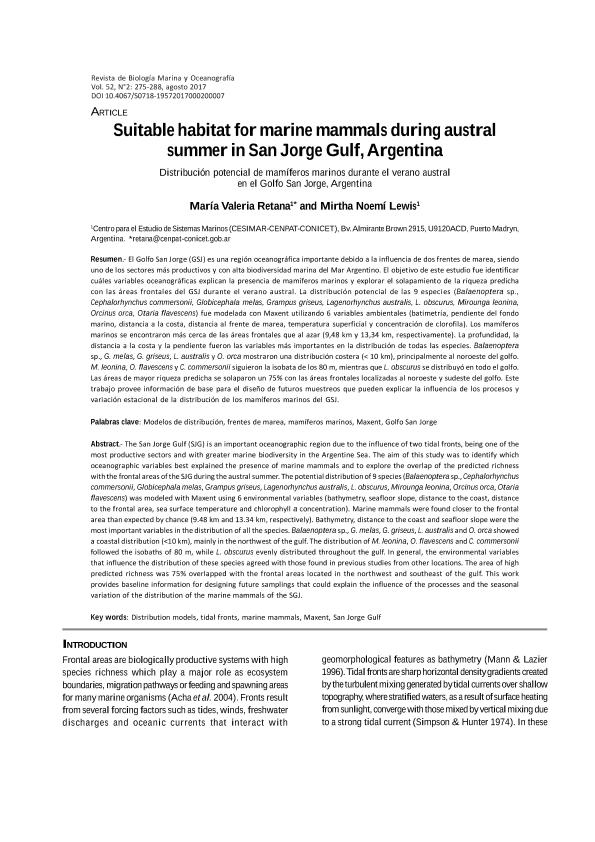Artículo
El Golfo San Jorge (GSJ) es una región oceanográfica importante debido a la influencia de dos frentes de marea, siendo uno de los sectores más productivos y con alta biodiversidad marina del Mar Argentino. El objetivo de este estudio fue identificar cuáles variables oceanográficas explican la presencia de mamíferos marinos y explorar el solapamiento de la riqueza predicha con las áreas frontales del GSJ durante el verano austral. La distribución potencial de las 9 especies (Balaenoptera sp., Cephalorhynchus commersonii, Globicephala melas, Grampus griseus, Lagenorhynchus australis, L. obscurus, Mirounga leonina, Orcinus orca, Otaria flavescens) fue modelada con Maxent utilizando 6 variables ambientales (batimetría, pendiente del fondo marino, distancia a la costa, distancia al frente de marea, temperatura superficial y concentración de clorofila). Los mamíferos marinos se encontraron más cerca de las áreas frontales que al azar (9,48 km y 13,34 km, respectivamente). La profundidad, la distancia a la costa y la pendiente fueron las variables más importantes en la distribución de todas las especies. Balaenoptera sp., G. melas, G. griseus, L. australis y O. orca mostraron una distribución costera (< 10 km), principalmente al noroeste del golfo. M. leonina, O. flavescens y C. commersonii siguieron la isobata de los 80 m, mientras que L. obscurus se distribuyó en todo el golfo. Las áreas de mayor riqueza predicha se solaparon un 75% con las áreas frontales localizadas al noroeste y sudeste del golfo. Este trabajo provee información de base para el diseño de futuros muestreos que pueden explicar la influencia de los procesos y variación estacional de la distribución de los mamíferos marinos del GSJ. The San Jorge Gulf (SJG) is an important oceanographic region due to the influence of two tidal fronts, being one of the most productive sectors and with greater marine biodiversity in the Argentine Sea. The aim of this study was to identify which oceanographic variables best explained the presence of marine mammals and to explore the overlap of the predicted richness with the frontal areas of the SJG during the austral summer. The potential distribution of 9 species (Balaenoptera sp., Cephalorhynchus commersonii, Globicephala melas, Grampus griseus, Lagenorhynchus australis, L. obscurus, Mirounga leonina, Orcinus orca, Otaria flavescens) was modeled with Maxent using 6 environmental variables (bathymetry, seafloor slope, distance to the coast, distance to the frontal area, sea surface temperature and chlorophyll a concentration). Marine mammals were found closer to the frontal area than expected by chance (9.48 km and 13.34 km, respectively). Bathymetry, distance to the coast and seafloor slope were the most important variables in the distribution of all the species. Balaenoptera sp., G. melas, G. griseus, L. australis and O. orca showed a coastal distribution (<10 km), mainly in the northwest of the gulf. The distribution of M. leonina, O. flavescens and C. commersonii followed the isobaths of 80 m, while L. obscurus evenly distributed throughout the gulf. In general, the environmental variables that influence the distribution of these species agreed with those found in previous studies from other locations. The area of high predicted richness was 75% overlapped with the frontal areas located in the northwest and southeast of the gulf. This work provides baseline information for designing future samplings that could explain the influence of the processes and the seasonal variation of the distribution of the marine mammals of the SGJ.
Suitable habitat for marine mammals during austral summer in San Jorge Gulf, Argentina
Título:
Distribución potencial de mamíferos marinos durante el verano austral en el Golfo San Jorge, Argentina
Fecha de publicación:
12/2017
Editorial:
Universidad de Valparaíso. Facultad de Ciencias del Mar
Revista:
Revista de Biología Marina y Oceanografía
ISSN:
0717-3326
e-ISSN:
0718-1957
Idioma:
Inglés
Tipo de recurso:
Artículo publicado
Clasificación temática:
Resumen
Archivos asociados
Licencia
Identificadores
Colecciones
Articulos(CESIMAR)
Articulos de CENTRO PARA EL ESTUDIO DE SISTEMAS MARINOS
Articulos de CENTRO PARA EL ESTUDIO DE SISTEMAS MARINOS
Articulos(SEDE CENTRAL)
Articulos de SEDE CENTRAL
Articulos de SEDE CENTRAL
Citación
Retana, Maria Valeria; Lewis, Mirtha Noemi; Suitable habitat for marine mammals during austral summer in San Jorge Gulf, Argentina; Universidad de Valparaíso. Facultad de Ciencias del Mar; Revista de Biología Marina y Oceanografía; 52; 2; 12-2017; 275-288
Compartir
Altmétricas




